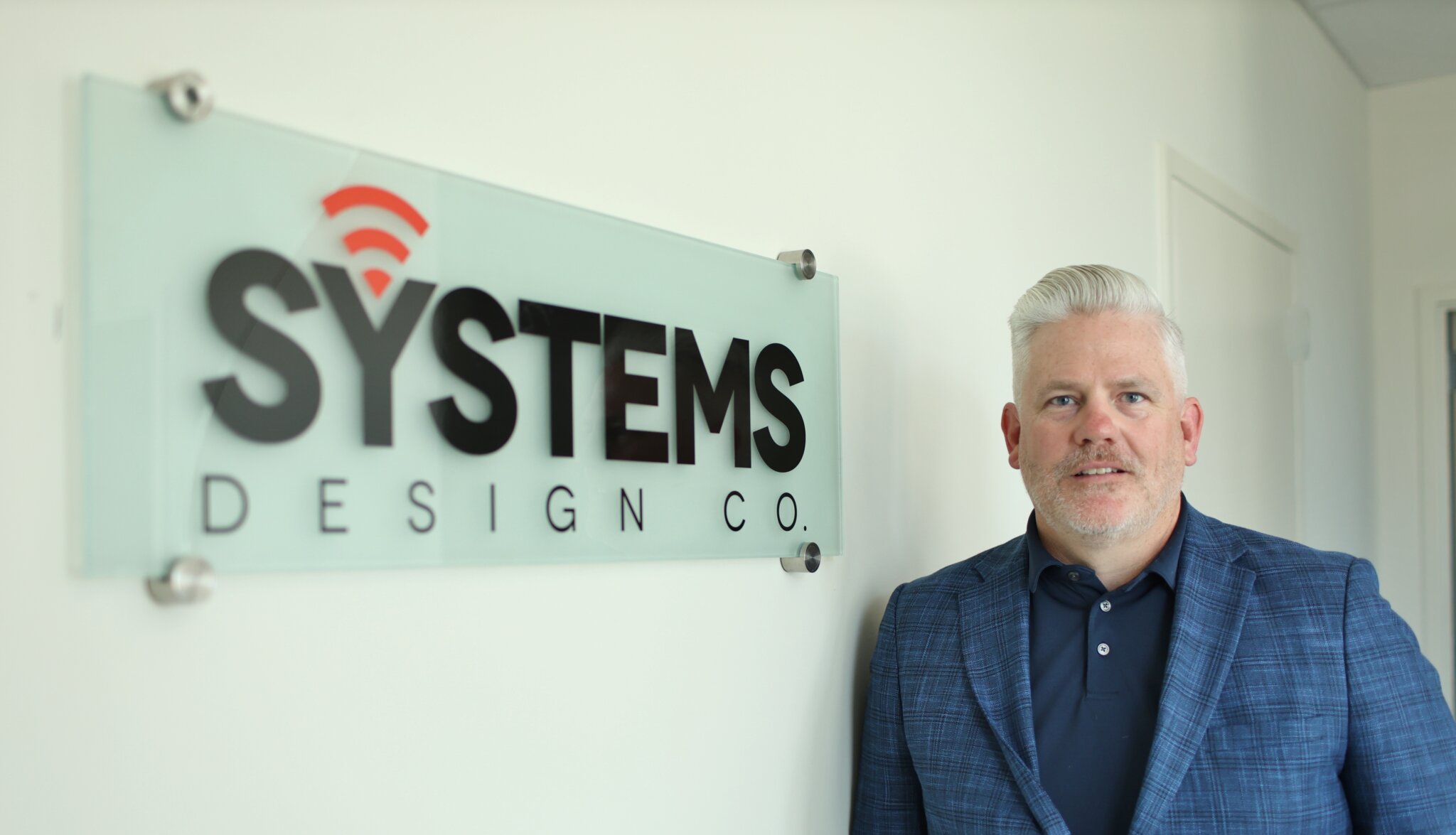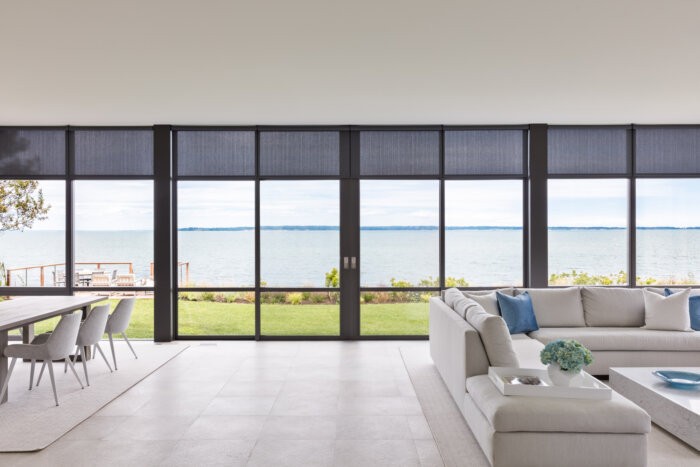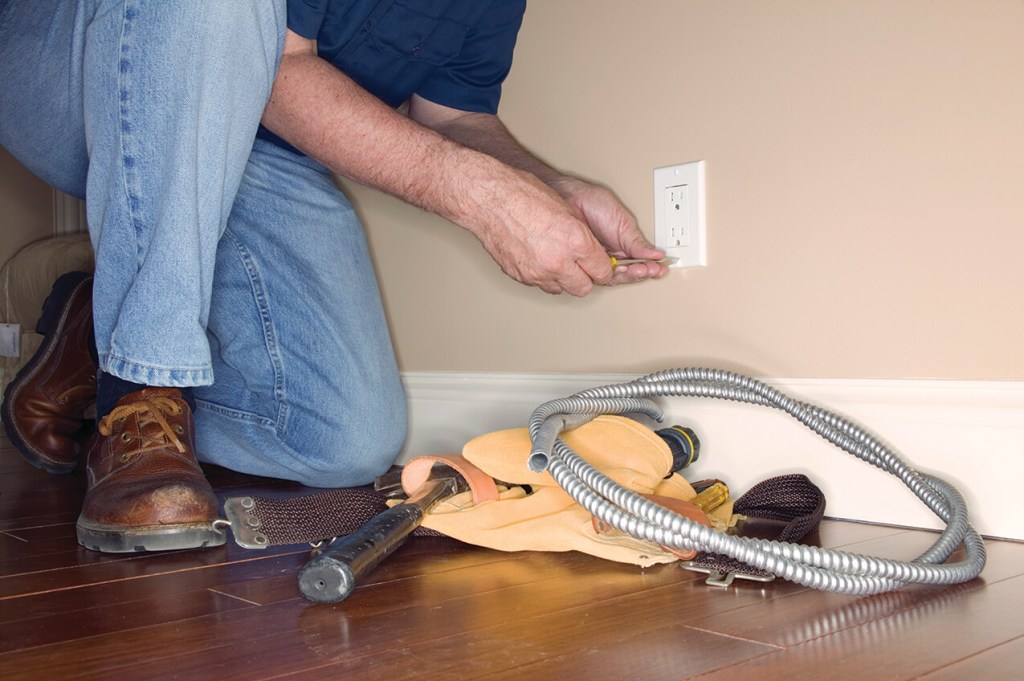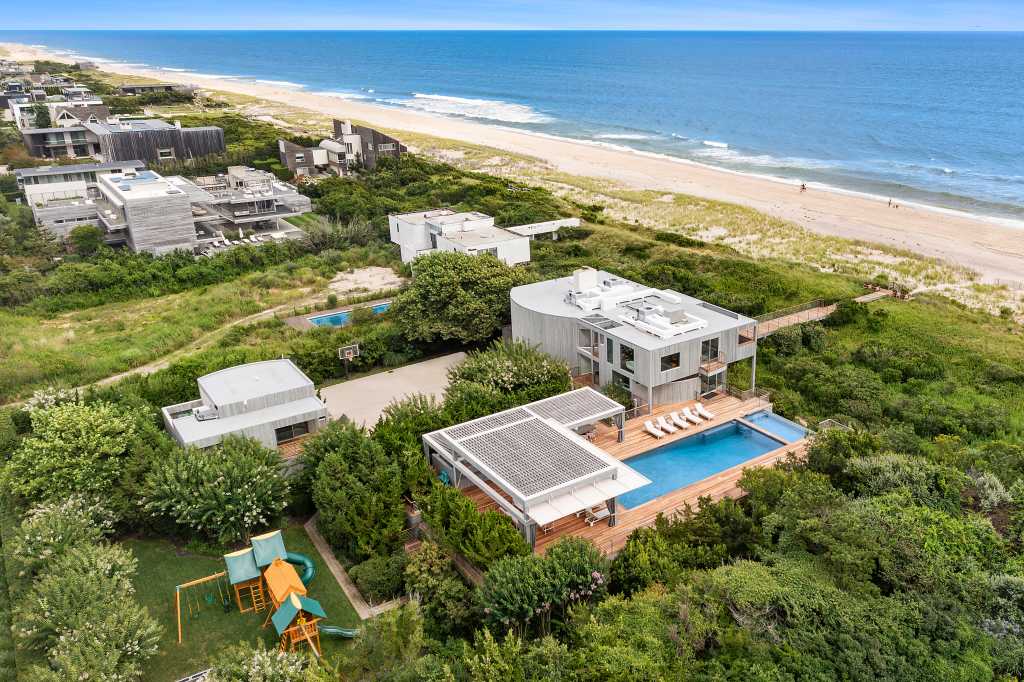System Design: Helping Hamptons Homes Go High Tech

When residents arrive at many Hamptons homes these days, they get a cool welcome, even when nobody’s home. And we’re not just talking about the temperature. High technology in the Hamptons is letting people hit welcome settings, turning everything on from lights to music and HVAC to pre-set levels.
Hamptons residences, in other words, are going high-tech as the newest technology is rolled out across the region, providing convenience and comfort with a little help from local integration companies.
“Technology is available for any size house. Most tech available for smaller houses are direct-to-consumer, DIY products,” says Curtis Cole, owner and president of Hamptons-based Systems Design Co. “These homes get commercial everything, commercial kitchens, commercial electrical and HVAC systems. We do systems that help larger residential homes manage all the subsystems in their homes.”
As people spend more time in the Hamptons, rather than just using homes for summer get-aways, they’re also spending more, not just on kitchen and bath renovations, but on high-tech upgrades for their homes.
“People are investing more in the technology for their homes,” Cole adds. “People like the ability to remotely control their house, their thermostats and lights.”
The ease of controlling smart homes remotely, from security to sound systems, is particularly appealing in the Hamptons, where this comes in handy while people are away. Systems Design, for instance, takes a suite of tech and makes it simple to use with easy interfaces.
“We really take these complicated systems in people’s houses and make them super simple, so they don’t have to think about it,” says Cole. “It’s the ability to control your home’s subsystems, so HVAC, lighting, motorized shades, pools, energy are all controlled through dedicated apps or a single easy to use system.”
Systems Design Co., the Dan’s Papers Best of the Best winners for Audio Video and Security for the last two years, started in the Hamptons in 2001. Over the past 23 years they have seen the technology people want in their homes change, and been a big part of that change. They meet with architects, builders and owners interested in including the latest home technologies into new homes and upgrading existing homes with the latest technologies.
“The systems we install can be built into new construction homes or retrofitted into existing homes,” Cole says of smart systems. “There is a lot of great wireless technology that lets us retrofit into existing homes.”
SMART HOMES
As smart homes get smarter, and the devices in them have apps, more systems are being consolidated via cell phones, keypads, iPads and other technology to control remotely and on premises.
Systems Design does about a dozen new construction projects each year ranging from $300,000 up to several million. Controls go beyond HVAC, temperature and lights to include audio and video systems, music, fireplaces, shades and security all wrapped into one app.
Hamptons homes are turning up the volume on technology as residents spend more time here, making a local presence from a tech solutions company and installer that is available 24/7 even more important.
“One of the biggest differentiators for us is we’re located in the Hamptons and we’re locally owned,” Cole says. “A lot of our competitors come out of New York City. Many of our local competitors have been purchased by national companies. Both struggle to provide the local, high touch 24/7 service our clients expect.”
Residents can consolidate 15 HVAC zones and ten lighting zones in one control via pre- settings, for instance, increasing comfort and ease. Using one convenient interface provides ease, but these systems also offer aesthetic benefits. You can remove wall clutter from traditional light switches and thermostats and consolidate a bank of light switches down to an elegant keypad. Thermostats can be removed from walls along with redundant keypads for audio, visual, security and pool control all operated via one easy app.
Systems Design uses various brands, such as Lutron for lighting and shade control and Savant and Crestron for AV and automation systems. “Many systems have really good dedicated apps, but many of our clients still prefer a single user interface for all of the systems in their home. It’s an intuitive interface,” Cole says of the importance of simplicity. “It’s clean and easy to use.”
THE TIME IS NOW
High tech is very much in the house these days in the Hamptons, as the region changes. The pandemic led people to spend more time here, living, working and playing. Improvements in tech infrastructure came at the same time, appearing at many houses here.
Systems Design, meanwhile, has a dedicated service team to manage existing clients and systems, as well as an installation team, and a 23-year track record. “I’ve been in this business since I graduated college,” Cole says. “I came out of college and went right into this industry on the manufacturing side. I was really lucky to find an industry where I could turn my love for music and technology into a career.”
He went into audio video, working as a manufacturer’s rep for Audtek Associates, doing sales, marketing and tech support for high-end audio video brands in the late ‘90s. He has seen and been part of the changing technology landscape, as Systems Design has grown. It now does work for many of the biggest Hamptons homes, providing luxury technology services as well as security.
He has now gone from representing bespoke audio brands on the manufacturer level to working directly with homeowners to bring those brands into their homes. “I love it,” Cole says. “It’s amazing how much fun I have with what we do.”
LIGHTS, CAMERA, REACTION
You can turn the lights out on the old-fashioned light switch. Rather than banks of light switches, Systems Design installs Lutron lighting keypads with presets scenes.
“One of the bigger things going on right now is to preset the lighting levels and the color of the light. In the days of incandescent lighting, we had a light bulb that would get warmer as it dims. With LED, it’s a fixed light temperature, generally fairly white,” Cole says. “There are newer LED technologies that let you adjust that color temperature. It’s not just dimming the light. It’s changing the color of the light.”
While there can be electrical savings and environmental benefits, Cole says the main “motivation is comfort, convenience and enjoyment.” Managing light in the home is not just about indoor light, but also the sunlight coming in from the outside.
“Modern architectural designs have become very popular, so there’s more glass,” Cole says of motorization using fabrics, curtain tracks for solar, blackout and other shades. “We have to use more sophisticated shading solutions.”
In addition to new construction, they do upgrades, recently upgrading the lighting control systems for the largest homes in the Hamptons in Sagaponack. They also take over a lot of existing systems installed by other integrators.
“We get a lot of calls from homeowners and caretakers who are unhappy with their existing AV guy. We are working on a project right now on the beach in Sagaponack where we have taken over servicing their system, and are upgrading their home theater and home control systems,” Cole says. “We’re putting a large video format display in their Peloton room.”
AUDIO VIDEO
Systems Design uses audio brands such as Savant, Crestron, James Audio, Origin Acoustics, Ambisonic Sound, Audio Control and Sonos, which provides speakers and music components for home theater and more, and Stealth Acoustics speakers, which can live up to their name.
“We have solutions for all kinds of aesthetic constraints, including invisible speakers.” Cole says. “You don’t see anything. You just hear it.”
They set up commercial grade home theaters with dedicated seating, soundproofing, acoustics and projectors. “Multi-purpose rooms can be turned into a home theater,” Cole adds. “You press a button and the screens and shades come down and it turns into a movie theater.”
Video is bridging entertainment and art, as screens are used to present artwork as well as content. “I think the cutting edge things in the audio video world are video walls, large format video displays that can be used for TV, movies and art,” Cole says of 150-inch to 160-inch video walls. “They’re dual purpose for digital art installations.”
OUTDOORS IS IN
Technology typically extends to the outdoors, allowing clients to push a button and create an ambiance in their backyard, including lighting, music, water and fire features and, if desired, TV.
“You don’t have to go to light switches, set them to the proper level, turn on pool fixtures, turn on music, TV, water features,” Cole says. “With us, it’s one button. The whole thing comes the way you want it.”
Systems Design installs many outdoor landscape speaker systems, so people can enjoy music across large properties. Installing only a few big speakers can lead to problems such as music too loud at one location and too soft at another.
“One mistake people make with outdoor audio is they put a pair of speakers in and don’t have sufficient coverage,” Cole says. “Then they have to turn the speakers up too loud. We put in systems with smaller speakers. They look like landscape lights and are spread around the property. It sounds better and the volume level is at a comfortable level throughout”
They offer various TVs, such as Samsung Outdoor and Sunbrite, designed for outdoors ranging from small to 100-inch diagonal screens from cSeed. You can create an outdoor interface that includes pool technology, managing pool temperature, vanishing edges, fountains, waterfalls, integrated lighting and speakers.
WI-FI
Even something as basic as wi-fi needs to be done right at large houses. In typical homes, cable service providers offer an all in one wi-fi solution. But bigger houses need bigger, better, more robust wi-fi networks.
“We have to put commercial grade networks in,” Cole says. “We have to cover 15,000 square feet and thousands of square feet of outdoor space with no dead zones.”
That requires different systems as well as network monitoring, management and updates similar to installing w-fi networks in hotels. But these networks typically are for work as well as pleasure. “In the Hamptons, if it’s someone who plans on spending more time there than the summer, they also focus on being able to work,” Cole says.
MAINTENANCE
Being locally-based has practical implications, including staff nearby available for maintenance and in case of problems. If something starts beeping in a house, wi-fi goes down, or another tech problem crops up, Systems Design can respond rapidly.
“We focus on high-end clientele and we provide unlimited local service and support to those customers,” Cole says. “Somebody calls us on a Sunday afternoon, we’re there. Someone calls on a Tuesday night, we’re there. Technology needs service. Always being available is important.”
As people conduct business from their homes, commercial grade wi-fi and networks need to operate without down time that can be costly. “If we have someone doing trading on the Asian stock exchange and their Internet goes down, they need to be able to reach us,” Cole adds. “We’re available twenty-four seven.”
SECURITY
Security includes standard door and window contacts, as well as much more high-tech variations such as monitored video. Cole says systems are starting to evolve into video-based security with video analytics to identify a person walking across your yard and being able to respond.
Integrating video analytics with home automation features like lights and door locks is becoming popular. They offer many variations on video products that can provide a new layer of security and are even beginning to offer security drones.
Getting the temperature right also is easy with high tech, even for large houses which seek comfort, convenience and energy efficiency. Many Hamptons homes are being outfitted with energy savings systems. One popular system is Energy Recovery Ventilator or ERV systems with air exchangers and variable- speed fans. These connect to your HVAC system to push fresh air into the home. Thermostats such as NEST, Cole says, aren’t compatible with variable speed systems.
“We work with HVAC contractors in order to provide an easy to use interface for what can be a complicated, energy efficient heating and cooling system. When a house calls for cooling, instead of kicking the fan in at ten, they ramp the fan up slowly and maintain that air flow, so it consumes less energy,” Cole says. “If it doesn’t get cool fast enough, it kicks the fan up and makes it faster.”
THE FUTURE IS NOW
Although cell phones and keypads are becoming more common ways to control smart homes, voice interaction is starting to become a bigger deal. Instead of or in addition to pressing a welcome button or using a cell phone, residents are telling systems what to do. While Alexa can work wonders, systems from companies like Josh AI provide customizable voice controls with some features that Cole says Alexa doesn’t offer.
Different residents, for instance, may refer to the same room with different words, such as den or family room, which Josh AI can manage. “You can teach Josh differences, nuances with the system,” Cole says. “When they say something, Josh still understands it.”
There are many unique elements to the Hamptons, but schedule is certainly one of them. Residents want their house ready, if at all possible, by the summer. “I think the challenge for the Hamptons is the project cycle you’re under. Everybody wants it to be done at a specific time, usually by Memorial Day weekend,” Cole says. “There usually isn’t that artificial deadline in other areas. If you finish a house in July in other areas, people don’t feel like they’re missing critical months.”
However you look at it, high tech can make people and their guests more welcome at their Hamptons home. Systems Design is busy designing, installing and maintaining systems. Will more people be saying “welcome” to launch scenes across their technology? Cole sees it happening, although for the moment saying the word “welcome” isn’t as common as using cell phones, keypads and other screens.
“You can say ‘welcome’ as you walk in your home,” Cole says. “That’s not as popular now. But as people get more comfortable with talking to their technology on their phones and computers, with AI and as technology gets better at listening and understanding what they want, I expect that to grow.”
PARTNER CONTENT










